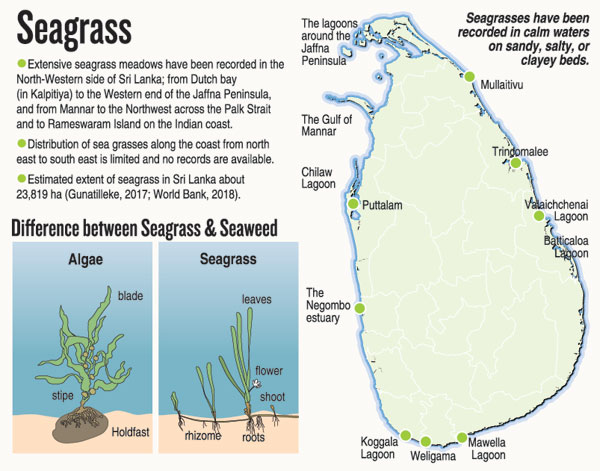News
All important, but little-known seagrass get their Day
View(s):By Malaka Rodrigo
The world marked the first Seagrass Day on March 1, following Sri Lanka’s proposal at the |UN last year, to declare a special day to raise awareness about this little recognised but important coastal habitat.
The main event in Sri Lanka was organised by the Environment Ministry followed by a workshop on using drones to map seagrass meadows.
Known as ‘Muhudu thruna’ in Sinhala and ‘Wattawa’ in Tamil, seagrasses are marine flowering plants found in shallow waters in many parts of the world, ranging from the tropics to the Arctic circle. They resemble grass on the land but play an important role in the marine environment by providing food, habitat and nursery areas for numerous fish and other marine organisms. They also absorb pollutants and nutrients in the water acting as good carbon sinks that help fight climate change.

Turtles graze on seagrass
There are 72 seagrass species in the world of which 15 are found in Sri Lanka’s coastal areas, says Susantha Udagedara of the Blue Resources Trust (BRT). It is estimated that Sri Lanka has at least 37,137 ha of seagrass meadows, with Negombo, Mannar, Jaffna, Batticaloa, Puttalam, Chilaw, Trincomalee, Polhena, Weligama, Nilawella being identified as areas with prominent seagrass meadows.
There are no species endemic to Sri Lanka due to its propagules distributed by ocean currents and out of species found here, one is categorised as “Endangered” six as “Near Threatened”, and two as “Least Concerned” according to the National Red List of 2012.
However, the composition and distribution of seagrasses along Sri Lanka’s coast are yet to be fully established. The number of species too could be higher, so more research is required, says Mr.Udagedara., who has studied seagrasses for over 11 years. He is also a member of the IUCN Species Survival Commission (SSC) Seagrass Specialist Group.
He was instrumental in getting an international day declared for seagrass through the United Nations. “The World Seagrass Association was trying to get a special day to raise awareness and after communicating our intentions to Hasanthi Dissanayake of Ocean Affairs, Environment and Climate Change of the Foreign Ministry, she took the initiative forward with the support of other officials,” Mr.Udagedara told the SundayTimes.

Seagrass found in Batticaloa. Pic courtesy Susantha Udagedara
Based on Sri Lanka’s proposal to declare a world seagrass day and 24 other countries supporting it, the United Nations General Assembly adopted the proposal on May 23 last year. On previous occasions too the UN adopted World Habitat Day and International recognition for Vesak following Sri Lanka’s proposals made in 1985 and 1997.
Close to 30% of the world’s seagrass meadows have already been lost, and the rate of decline of the meadows has accelerated since the 1990s. Currently, an estimated 110 square kilometres of seagrass is lost annually; the equivalent of two football fields of seagrass being lost every hour.
Industrial and agricultural runoff, coastal development, unregulated fishing, aquaculture, and tourism activities can largely harm seagrasses. “As a country that proposed world Seagrass day, we are serious about conserving this ecosystem,” said Environment ministry secretary Dr Anil Jasinghe.
Inspite of covering only 0.1 percent of the world’s ocean floor, seagrass meadows are highly efficient carbon sinks, storing up to 18 percent of the world’s oceanic carbon. It is believed 9 billion tonnes of carbon are stored in seagrass meadows globally and if they are destroyed, this carbon will be released into the environment contribute to rising global warming, Dr Jasinghe said.
IUCN former country representative Dr Ananda Mallawatantri said studies on seagrass meadows by young scientists like Udagedara could make Sri Lanka a global hub for such research. As Sri Lanka is looking to establishing an International University of Climate Change, these are the kinds of research that can attract foreign scientists to Sri Lanka, he pointed out.
As a way forward, a national data-gathering platform to collect knowledge on seagrasses as well as a management plan will be developed, said head of Biodiversity Secretariat Padma Abeykoon.

Marking Seagrass Day with a workshop in Mannar
Meanwhile, to mark Seagrass day the Environment Ministry with the support of Sri Lankan Airlines and Blue Resources Trust organised a workshop on using drones to monitor and map seagrass areas here. Government agencies involved in marine and biodiversity conservation participated in the workshop conducted by internationally acclaimed scientist Dr Milica Stankovic from Thailand.
Dr Stankovic said that the first step in conserving seagrasses was mapping out the areas where they are, but since it is a cumbersome task to dive and individually map the area drone technology can be effectively used to locate the seagrass areas. The expert also emphasised the importance of measuring the carbon stored in the seagrasses to conserve this ecosystem.
Seagrasses are also the staple food for critically endangered dugongs. When these mammals graze the seagrasses they mark a trail and these footages can be used to monitor the areas that dugongs inhabit and the data can be used to declare such places as protected areas, Dr Stankovic said at the workshop held in Mannar.

The best way to say that you found the home of your dreams is by finding it on Hitad.lk. We have listings for apartments for sale or rent in Sri Lanka, no matter what locale you're looking for! Whether you live in Colombo, Galle, Kandy, Matara, Jaffna and more - we've got them all!

